tire type OLDSMOBILE SILHOUETTE 1996 Owners Manual
[x] Cancel search | Manufacturer: OLDSMOBILE, Model Year: 1996, Model line: SILHOUETTE, Model: OLDSMOBILE SILHOUETTE 1996Pages: 372, PDF Size: 19.39 MB
Page 173 of 372
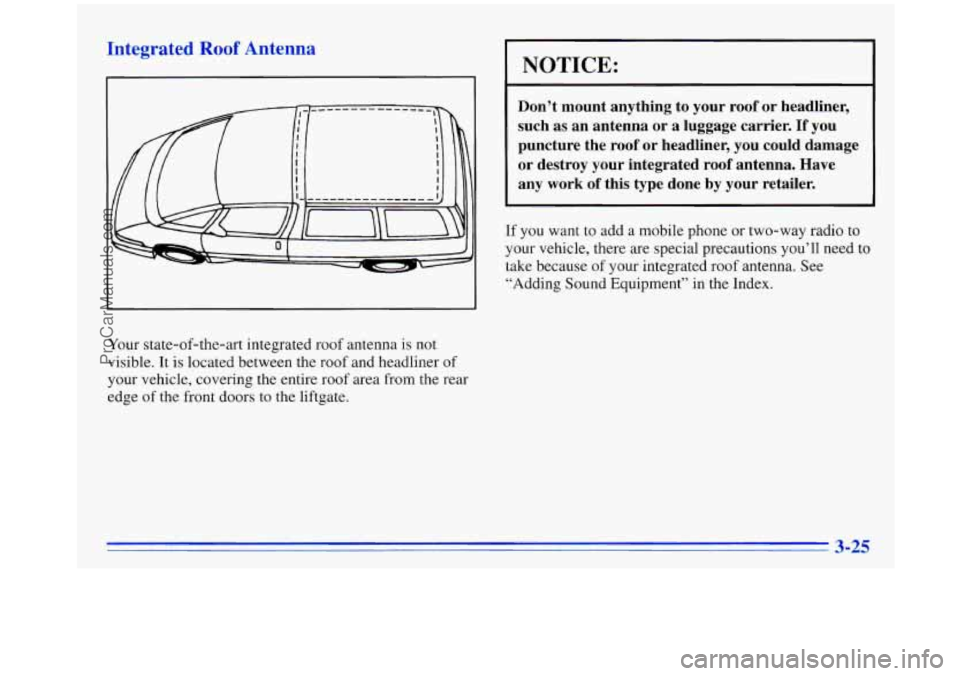
Integrated Roof Antenna
‘Your state-of-the-art integrated roof antenna is not
visible. It is located between the roof and headliner
of
your vehicle, covering the entire roof area from the rear
edge
of the front doors to the liftgate.
NOTICE:
Don’t mount anything to your roof or headliner,
such as an antenna or a luggage carrier.
If you
puncture the roof or headliner, you could damage or destroy your integrated roof antenna. Have
any work
of this type done by your retailer.
If you want to add a mobile phone or two-way radio to
your vehicle, there are special precautions you’ll need to
take because of your integrated roof antenna. See
“Adding Sound Equipment” in the Index.
3-25
ProCarManuals.com
Page 186 of 372
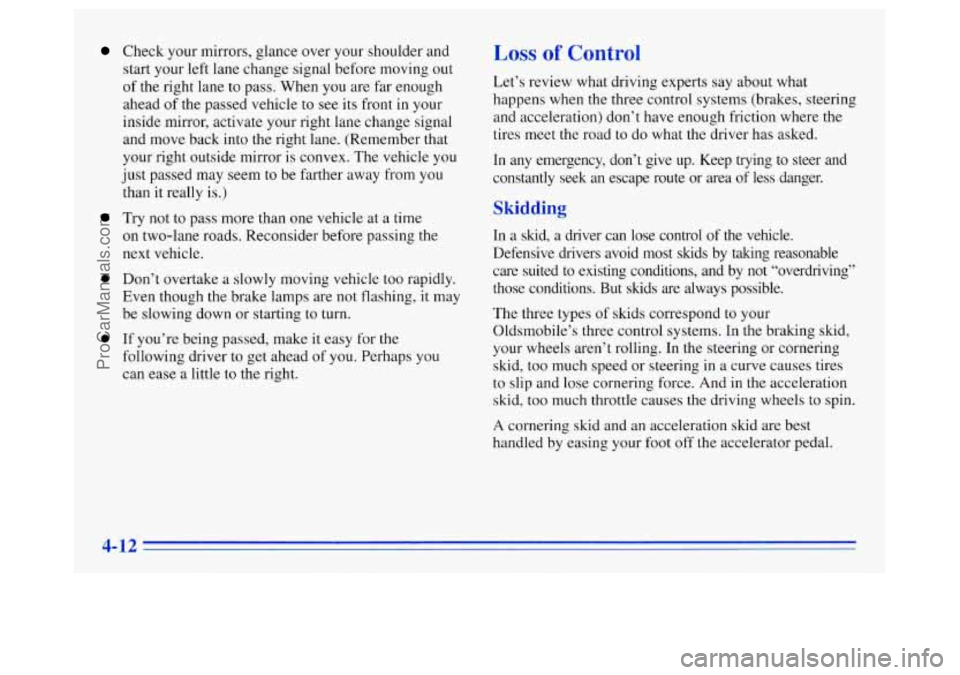
Check your mirrors, glance over your shoulder and
start your left lane change signal before moving out
of the right lane to pass. When you are far enough
ahead of the passed vehicle to see its front in your
inside mirror, activate your right lane change signal
and move back into the right lane. (Remember that
your right outside mirror is convex. The vehicle you
just passed may seem to be farther away from you
than it really is.)
Try not to pass more than one vehicle at a time
on two-lane roads. Reconsider before passing the
next vehicle.
0 Don’t overtake a slowly moving vehicle too rapidly.
Even though the brake lamps are not flashing, it may
be slowing down or starting to turn.
0 If you’re being passed, make it easy for the
following driver to get ahead of you. Perhaps you
can ease a little
to the right.
Loss of Control
Let’s review what driving experts say about what
happens when the three control systems (brakes, steering
and acceleration) don’t have enough friction where the
tires meet the road to do what the driver has asked.
In any emergency, don’t give up. Keep trying to steer and
constantly seek an escape route or area of less danger.
Skidding
In a skid, a driver can lose control of the vehicle.
Defensive drivers avoid most skids by taking reasonable
care suited to existing conditions, and by not “overdriving”\
those conditions. But skids are always possible.
The three types of skids correspond to your
Oldsmobile’s three control systems. In the braking skid,
your wheels aren’t rolling. In the steering or cornering
skid, too much speed or steering in a curve causes tires
to slip and lose cornering force. And
in the acceleration
skid, too much throttle causes the driving wheels to spin.
A cornering skid and an acceleration skid are best
handled by easing your foot off the accelerator pedal.
4-12
ProCarManuals.com
Page 219 of 372
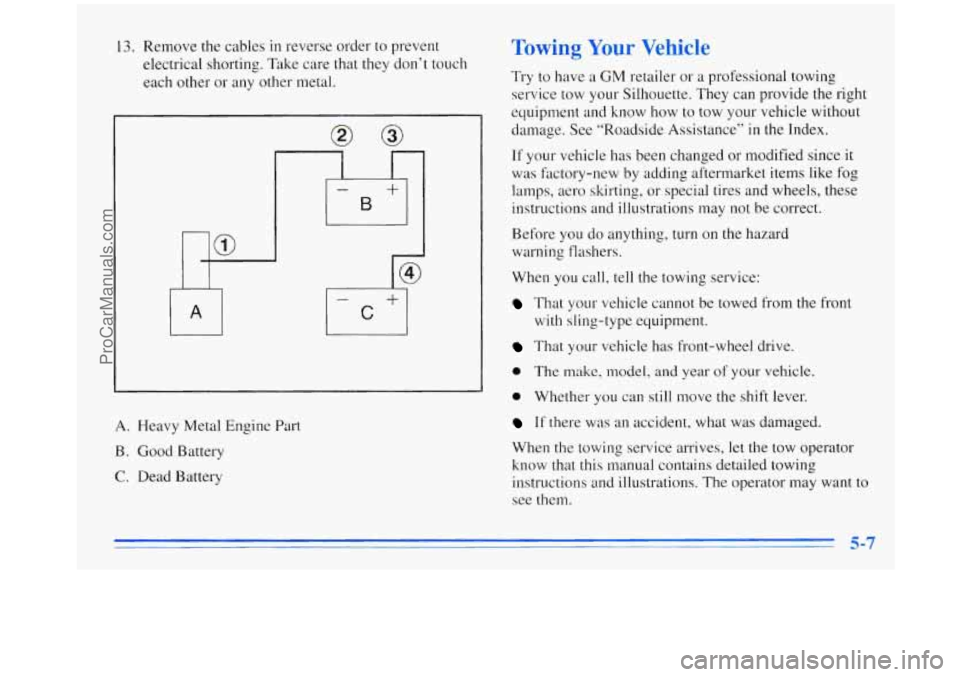
13. Remove the cables in reverse order to prevent
electrical shorting. Take care that
they don’t touch
each other or any other metal.
A. Heavy Metal Engine Part
B. Good Battery
C. Dead Battery
Towing Your Vehicle
Try to have a GM retailer or a professional towing
service tow your Silhouette. They can provide the right
equipment and know how to tow your vehicle without
damage. See “Roadside Assistance”
in the Index.
If your vehicle has been changed or modified since it
was factory-new by adding aftermarket items like fog
lamps, aero skirting, or special tires and wheels, these
instructions and illustrations may not be correct.
Before you do anything, turn on
the hazard
warning flashers.
When
you call, tell the towing service:
That your vehicle cannot be towed from the front
with sling-type equipment.
That your whicle has front-wheel drive.
0 The make, model, and year of your vehicle.
0 Whether you can still move the shift lever.
If there was an accident, what was damaged.
When the towing service arrives,
let the tow operator
know that this manual contains detailed towing
instructions and illustrations.
The operator may want to
see them.
5-7
ProCarManuals.com
Page 279 of 372
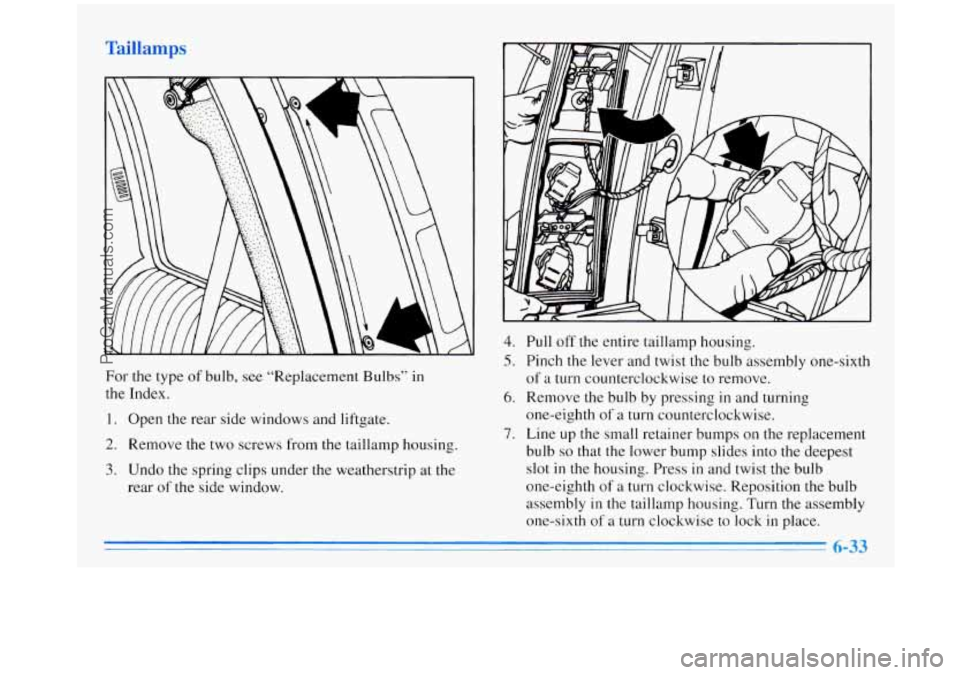
For the type of bulb, see “Replacement Bulbs” in
the Index.
1. Open the rear side windows and liftgate.
2. Remove the two screws from the taillamp housing.
3. Undo the spring clips under the weatherstrip at the
rear of the side window.
4. Pull off the entire taillamp housing.
5. Pinch the lever and twist the bulb assembly one-sixth
of a turn counterclockwise to remove.
6. Remove the bulb by pressing in and turning
one-eighth
of a turn counterclockwise.
7. Line up the small retainer bumps on the replacement
bulb
so that the lower bump slides into the deepest
slot
in the housing. Press in and twist the bulb
one-eighth
of a turn clockwise. Reposition the bulb
assembly
in the taillamp housing. Turn the assembly
one-sixth of
a turn clockwise to lock in place.
ProCarManuals.com
Page 280 of 372
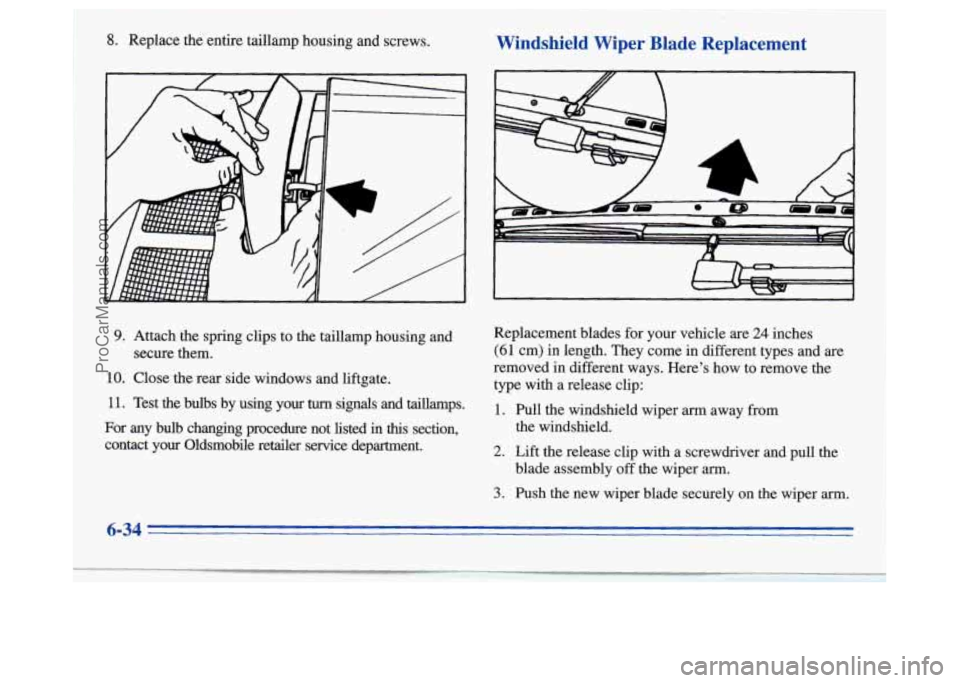
8. Replace the entire taillamp housing and screws. Windshield Wiper Blade Replacement
9. Attach the spring clips to the taillamp housing and
secure them.
10. Close the rear side windows and liftgate.
11. Test the bulbs by using your turn signals and taillamps.
For any bulb changing procedure not listed in
this section,
contact your Oldsmobile retailer service department. Replacement blades for
your vehicle are
24 inches
(61 cm) in length. They come in different types and are
removed in different ways. Here’s how to remove the
type with a release clip:
1. Pull the windshield wiper arm away from
the windshield.
2. Lift the release clip with a screwdriver and pull the
3. Push the new wiper blade securely on the wiper arm.
blade assembly off the wiper arm.
6-34
ProCarManuals.com
Page 282 of 372
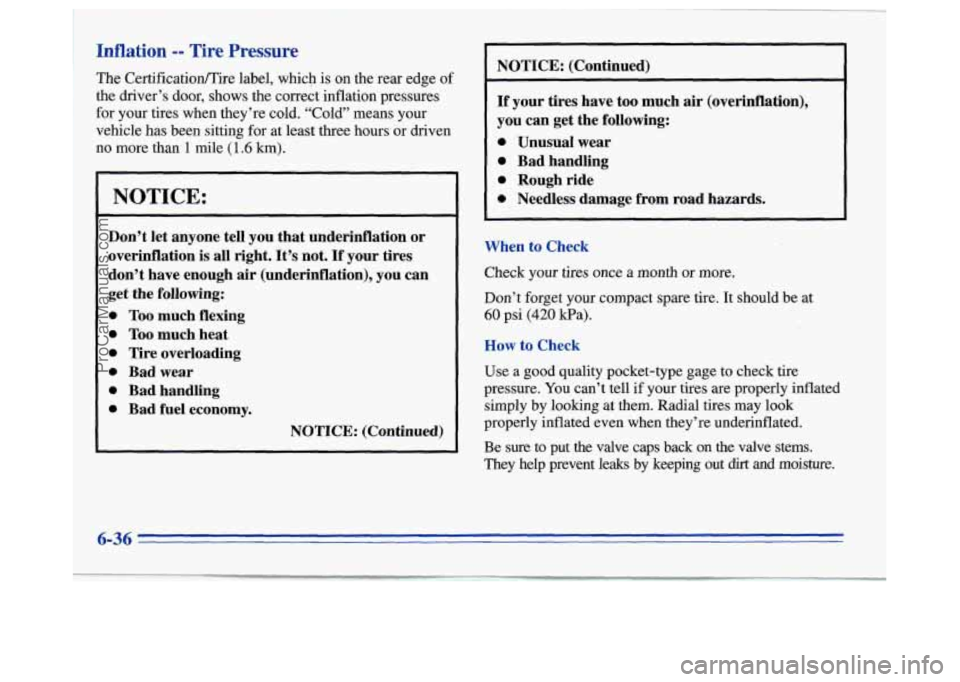
Inflation -- Tire Pressure
The CertificationlTire label, which is on the rear edge 01
the driver’s door, shows the correct inflation pressures
for your tires when they’re cold. “Cold” means your
vehicle has been sitting for at least three hours or driven
no more than
1 mile (1.6 km).
NOTICE:
Don’t let anyone tell you that underinflation or
overinflation is all right. It’s not.
If your tires
don’t have enough
air (underinflation), you can
get the following:
0 Too much flexing
0 Too much heat
0 Tire overloading
0 Bad wear
0 Bad handling
0 Bad fuel economy.
NOTICE: (Continued)
NOTICE: (Continued) I
If your tires have too much air (overinflation).
you can get the following:
0 Unusual wear
0 Bad handling
0 Rough ride
0 Needless damage from road hazards.
When to Check
Check your tires once a month or more.
Don’t forget your compact spare tire. It should be at
60 psi (420 Wa).
How to Check
Use a good quality pocket-type gage to check tire
pressure. You can’t tell if your tires are properly inflated
simply by looking
at them. Radial tires may look
properly inflated even when they’re underinflated.
Be
sure to put the valve caps back on the valve stems.
They help prevent leaks by keeping out dirt and moisture.
6-36
ProCarManuals.com
Page 284 of 372
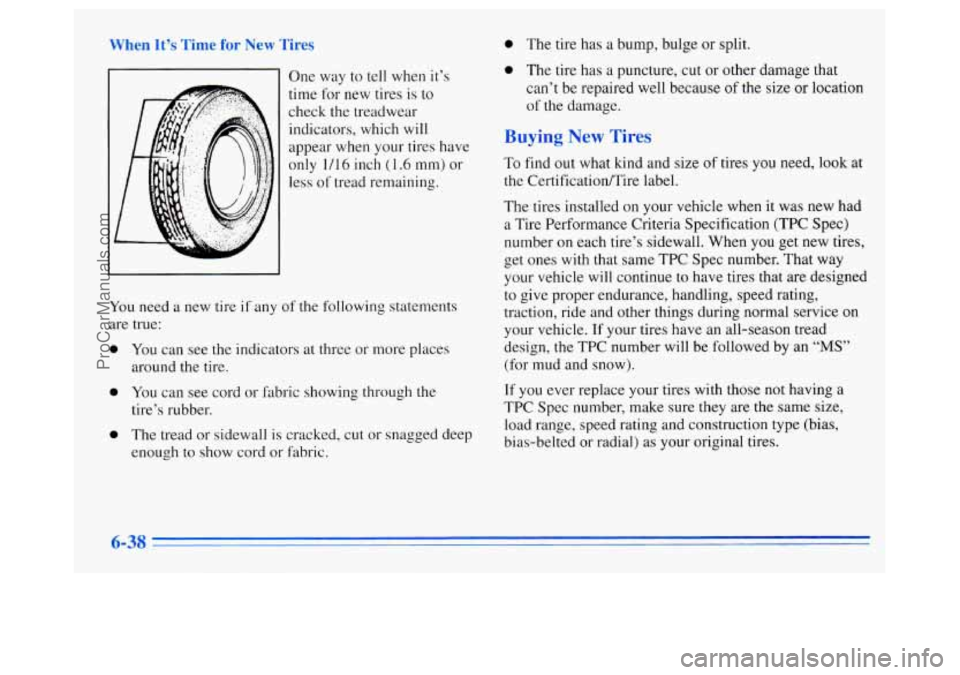
!n It’s Vew Tires 0 The tire has a bump, bulge or split.
One way
to tell when it’s
time for new tires
is to
check the treadwear indicators, which will
appear when your tires have
only
1/16 inch (1.6 mm) or
less of tread remaining.
0 The tire has a puncture, cut or other damage that
can’t be repaired well because
of the size or location
of the damage.
Buyinp Nc - . .? Tires
To find out what kind and size of tires you need, look at
the CertificatiodTire label.
You need a new tire if any
of the following statements
are true:
0 You can see the indicators at three or more places
around the tire.
0 You can see cord or fabric showing through the
tire’s rubber.
0 The tread or sidewall is cracked, cut or snagged deep
enough to show cord or fabric. The
tires installed on your vehicle when it was new had
a Tire Performance Criteria Specification
(TPC Spec)
number on each tire’s sidewall. When
you get new tires,
get ones with that same TPC Spec number. That way
your vehicle will continue to have tires that are designed
to give proper endurance, handling, speed rating,
traction, ride and other things during normal service on
your vehicle. If your tires have an all-season tread
design, the TPC number will be followed by an
“MS”
(for mud and snow).
If you ever replace your tires with those not having a
TPC Spec number, make sure they are the same size,
load range, speed rating and construction type (bias,
bias-belted or radial) as your original tires.
3
ProCarManuals.com
Page 285 of 372
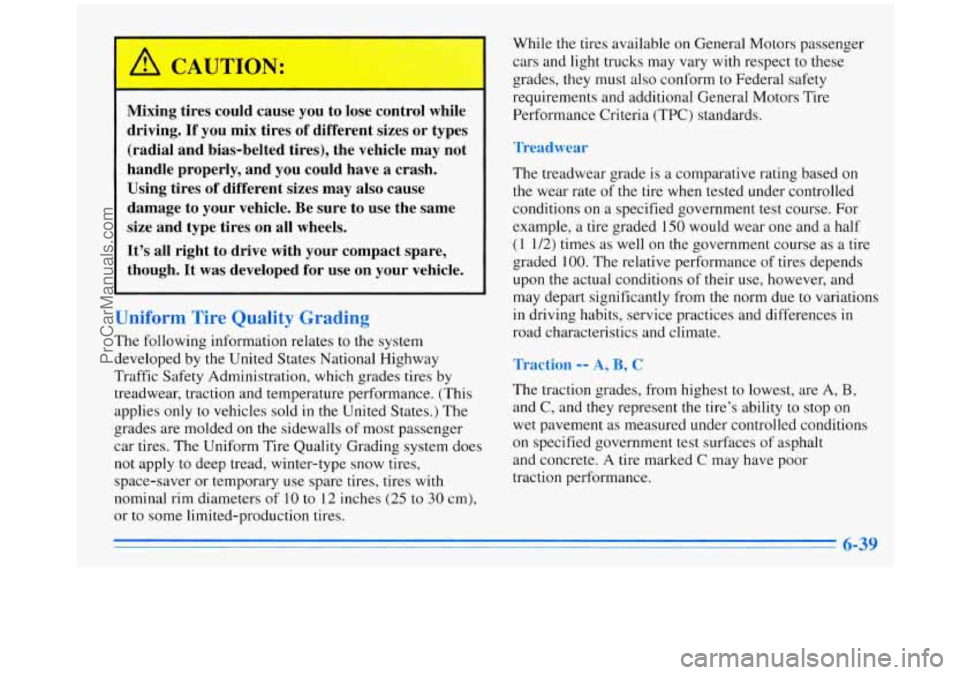
Mixing tires could cause you to lose control while
driving.
If you mix tires of different sizes or types
(radial and bias-belted tires), the vehicle may not
handle properly, and you could have
a crash.
Using tires of different sizes may also cause
damage to your vehicle. Be sure to use the same
size and type tires on all wheels.
It’s all right to drive with your compact spare,
though. It was developed for use on your vehicle.
Uniform Tire Quality Grading
The following information relates to the system
developed by the United States National Highway
Traffic Safety Administration, which grades tires by
treadwear, traction and temperature performance. (This
applies only
to vehicles sold in the United States.) The
grades are molded on the sidewalls
of most passenger
car tires. The Uniform Tire Quality Grading system does
not apply to deep tread, winter-type snow tires,
space-saver or temporary
use spare tires, tires with
nominal rim diameters
of 10 to 12 inches (25 to 30 cm),
or to some limited-production tires. While
the tires available on General Motors passenger
cars and light trucks may vary with respect to these
grades, they must
also conform to Federal safety
requirements and additional General Motors Tire
Performance Criteria
(TPC) standards.
Treadwear
The treadwear grade is a comparative rating based on
the wear rate of the tire when tested under controlled
conditions on
a specified government test course. For
example,
a tire graded 150 would wear one and a half
(1 1/2) times as well on the government course as a tire
graded
100. The relative performance of tires depends
upon the actual conditions
of their use, however, and
may depart significantly from the norm due to variations
in driving habits, service practices and differences in
road characteristics and climate.
Traction -- A, B, C
The traction grades, from highest to lowest, are A, B,
and C, and they represent the tire’s ability to stop on
wet pavement
as measured under controlled conditions
on specified government test surfaces of asphalt
and concrete. A tire marked
C may have poor
traction performance.
6-39
ProCarManuals.com
Page 288 of 372
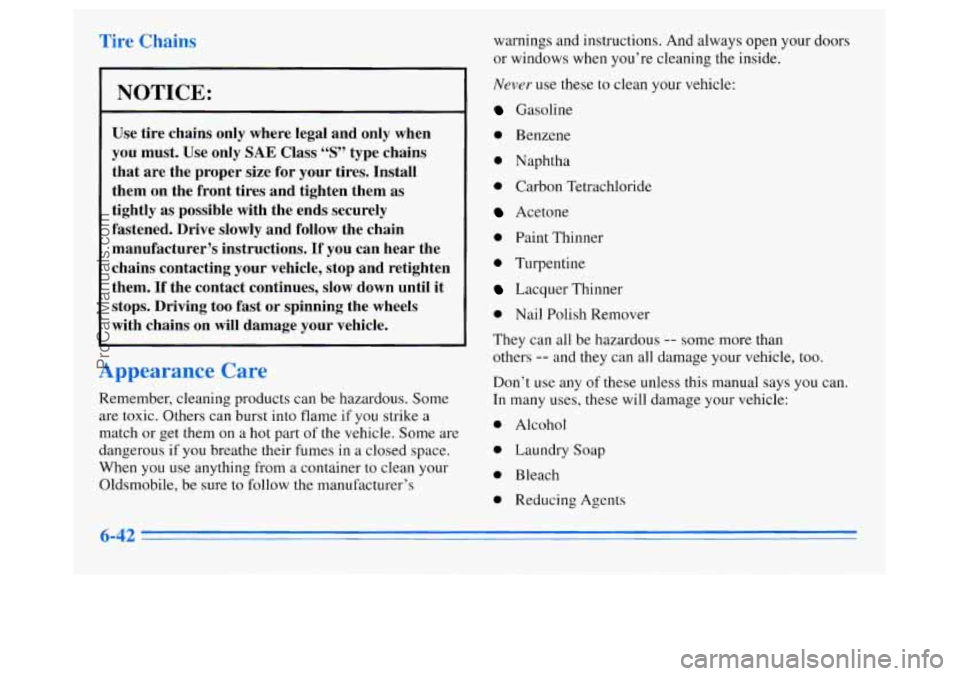
Tire Chains,
I NOTICE:
Use tire chains only where legal and only when
you must. Use only
SAE Class “S” type chains
that are the proper size for your tires. Install
them on the front tires and tighten them as
tightly as possible with the ends securely
fastened. Drive slowly and follow the chain
manufacturer’s instructions.
If you can hear the
chains contacting your vehicle, stop and retighten
them. If the contact continues,
slow down until it
stops. Driving too fast or spinning the wheels
with chains on will damage your vehicle.
Appearance Care
Remember, cleaning products can be hazardous. Some
are toxic. Others can burst into flame if you strike a
match or get them on a
hot part of the vehicle. Some are
dangerous if you breathe their fumes in a closed space.
When you use anything from a container to clean your
Oldsmobile, be sure to follow the manufacturer’s warnings and instructions.
And always open your doors
or windows when you’re cleaning the inside.
Never use these to clean your vehicle:
Gasoline
0 Benzene
0 Naphtha
0 Carbon Tetrachloride
Acetone
0 Paint Thinner
0 Turpentine
Lacquer Thinner
0 Nail Polish Remover
They can all be hazardous
-- some more than
others
-- and they can all damage your vehicle, too.
Don’t use any of these unless this manual says you can.
In many uses, these will damage your vehicle:
0 Alcohol
0 Laundry Soap
0 Bleach
0 Reducing Agents
6-42
ProCarManuals.com
Page 289 of 372
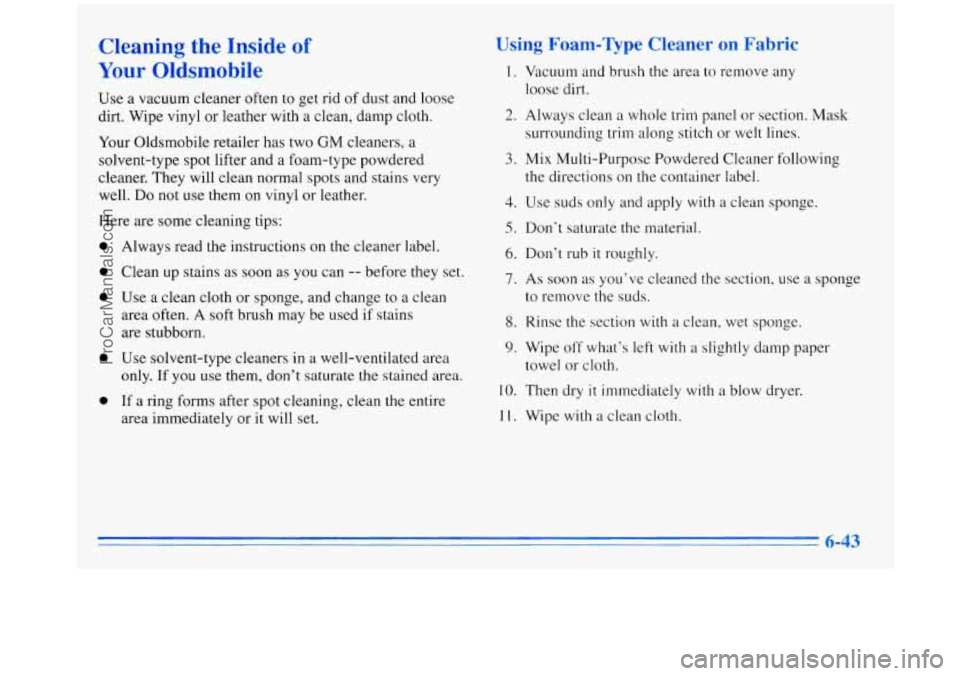
Cleaning the Inside of
Your Oldsmobile
Use a vacuum cleaner often to get rid of dust and loose
dirt. Wipe vinyl or leather with a clean, damp cloth.
Your Oldsmobile retailer has two
GM cleaners, a
solvent-type spot lifter and a foam-type powdered
cleaner. They will clean normal spots and stains very
well. Do not
use them on vinyl or leather.
Here are some cleaning tips:
0
0
0
0
0
Always read the instructions on the cleaner label.
Clean up stains as soon as you can
-- before they set.
Use a clean cloth or sponge, and change to a clean
area often. A soft brush may be used if stains
are stubborn.
Use solvent-type cleaners
In a well-ventilated area
only. If you use them, don’t saturate the stained area.
If a ring forms after spot cleaning, clean the entire
area immediately or it will set.
Using Foam-vpe Cleaner on Fabric
I. Vacuum and brush the area to remove any
loose dirt.
2. Always clean a whole trim panel or section. Mask
surrounding trim along stitch
or welt lines.
3. Mix Multi-Purpose Powdered Cleaner following
the directions on the container label.
4. Use suds only and apply with a clean sponge.
5. Don’t saturate the material.
6. Don’t rub it roughly.
7. As soon as you’ve cleaned the section, use a sponge
to remove the suds.
8. Rinse the section with a clean, wet sponge.
9. Wipe off what’s left with a slightly damp paper
towel or cloth.
10. Then dry it immediately with a blow dryer.
11. Wipe with a clean cloth.
6-43
ProCarManuals.com